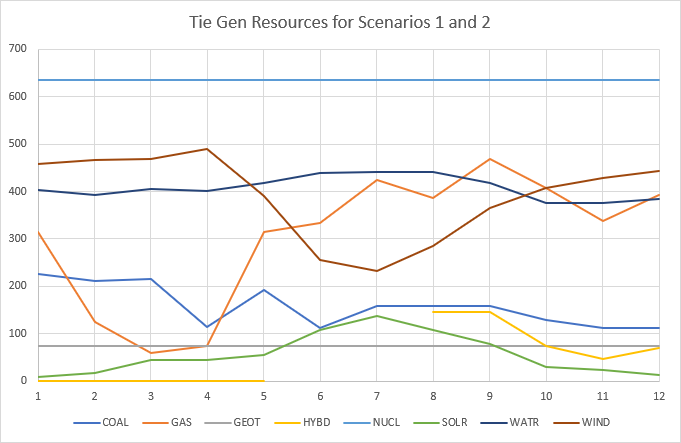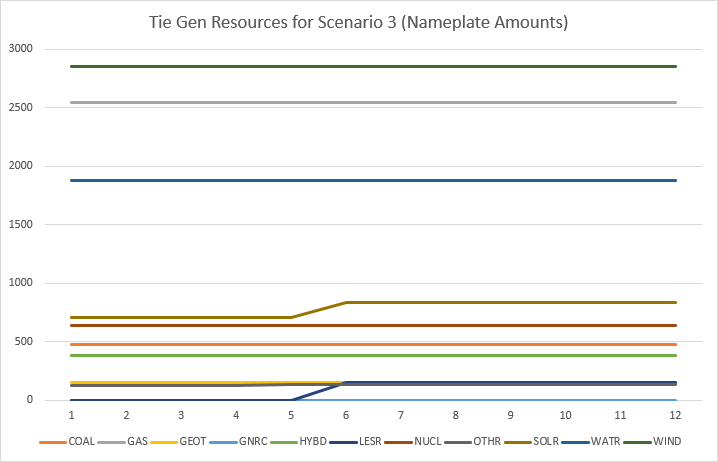1.
Please provide your organization’s feedback on the draft inputs and assumptions.
The Public Advocates Office at the California Public Utilities Commission (Cal Advocates) is the independent ratepayer advocate at the California Public Utilities Commission (CPUC). Our goal is to ensure that California ratepayers have affordable, safe, and reliable utility services while advancing the state’s environmental goals. Cal Advocates offers the following recommendations on the California Independent System Operator’s (CAISO) draft inputs and assumptions for the Resource Adequacy Modeling and Program Design Initiative:
- The CAISO should develop a shaped PLEXOS[1] import constraint in place of the proposed draft PLEXOS import constraints. The shape of the import constraint should allow for flows from both specified and unspecified resource adequacy (RA) import resources. An hourly shaped import constraint would improve upon the draft inputs and assumptions by properly accounting for the hourly shape of generation from imported variable energy resource (VERs), in addition to unspecified RA import levels.
- The CAISO should revise the set of resource identifiers (IDs) that contribute to the import constraint, to remove: a) any capacity associated with retiring resources, b) resources that serve non-CAISO load-serving entities (LSEs), and c) system resources that function as unspecified imports for modeling purposes. The removal of these resource IDs will result in a more accurate representation of the specified RA import capacity available to CAISO LSEs.
Background: The CAISO’s draft inputs and assumptions documentation includes two sets of import constraints for the CAISO’s 2025 modeling. For Scenario 1, where the resource level is capped at LSEs’ RA obligations, and Scenario 2, where the resource level is capped at LSEs’ historical RA showings, the CAISO’s draft import constraints use the average 2019-2024 import levels of qualifying capacity.[2] For Scenario 3, where the resource level includes all RA-eligible resources, the CAISO’s draft import constraints include a “net import limit” that includes both RA imports and economic imports. This Scenario 3 draft net import limit is set to 5,500 megawatts (MW) in hours ending 16 through 22 from June through September and to 11,665 MW, or the portion of the Maximum Import Capability (MIC) available to LSEs, for all other hours.[3] CAISO staff also provided the following total import constraint values by month for each scenario, in an October 28, 2024 email response to a question from Cal Advocates:[4]
|
Month
|
1
|
2
|
3
|
4
|
5
|
6
|
7
|
8
|
9
|
10
|
11
|
12
|
|
Scenario 1
|
2,853
|
2,642
|
2,682
|
2,887
|
3,687
|
4,322
|
6,339
|
5,777
|
7,110
|
4,374
|
2,931
|
2,898
|
|
Scenario 2
|
2,853
|
2,642
|
2,682
|
2,887
|
3,687
|
4,322
|
6,639
|
6,077
|
7,110
|
4,374
|
2,931
|
2,898
|
|
Scenario 3
|
11,665
|
11,665
|
11,665
|
11,665
|
11,665
|
5,500
|
5,500
|
5,500
|
5,500
|
11,665
|
11,665
|
11,665
|
CAISO staff provided the following tie-generator category breakdown for Scenarios 1 and 2. The CAISO described these MW values as “[Qualifying Capacity (QC)] amounts based on historical RA showings”:[5]

Finally, the CAISO provided the following tie-generator category breakdown for Scenario 3 (nameplate MW). These capacities reflect the summed capacities of all imports with CAISO resource IDs:

Discussion: The CAISO’s draft import constraints are inappropriate inputs for two reasons. First, the draft import constraints do not match the hourly shape of generation from specified imports, which include a significant and growing proportion of VERs. For Scenarios 1 and 2, the import constraint allowances for solar and wind resources are capped at “QC amounts based on historical RA showings,” according to the CAISO’s October 28, 2024 email to Cal Advocates. However, VERs produce shaped generation profiles in which a VER’s generation level may be lower or higher in any given hour, compared to the VER’s QC. For example, solar resources’ generation can approach their nameplate MW capacity levels in the middle of a summer day, while dropping to zero during nighttime hours. The use of an import constraint that reflects a fixed import flow from solar resources, at the corresponding QC levels, may artificially reduce solar imports in midday hours.
Similarly, for Scenario 3, the 5,500 MW import constraint for hours ending 16 through 22 in June through September may be lower than the total hourly generation from specified and unspecified RA imports during this same time period.[6] This import constraint risks the artificial reduction of energy from RA imports.
The second reason that the CAISO’s draft import constraints are inappropriate inputs is that the Scenario 3 import capacities are based on the total set of external CAISO resource IDs, rather than the subset of these resources that serve CAISO load. The CAISO’s use of the larger set of resource IDs overestimates the specified import capacity that is actually available to CAISO LSEs.[7] For example, Scenario 3 includes 2,549 nameplate MWs of specified gas imports, whereas the CAISO’s calculation of the LSEs’ 2019-2024 RA showings included a September average of only 469 MWs of specified gas imports (see charts above). Likewise, Scenario 3 includes 1,875 nameplate MWs of specified hydro imports, whereas the CAISO’s calculation of the LSEs’ 2019-2024 RA showings included a September average of only 419 MWs of specified hydro imports (see charts above).
The primary cause of the excessive Scenario 3 nameplate levels appears to be the inclusion of some external resources that do not regularly serve CAISO load but nonetheless retain CAISO resource IDs.[8] Some of these resources may be contracted to serve external load, such as GRIFFI_2_LSPDYN (Griffith Energy).[9] Others may be so-called “system resources” used for market participation by multiple external resources participating as a single resource. For modeling purposes, such system resources are akin to unspecified imports and should not be treated as specified imports. For example, the resource ID “MALIN_5_BPADYN” does not represent a pseudo-tie or a dynamically scheduled VER but rather the system resource that allows Bonneville Power Administration (BPA) to market up to 700 MWs of capacity from the ten hydro facilities of the Federal Columbia River Power System.[10]
Finally, in all three scenarios, the CAISO includes 477 nameplate MWs of specified coal imports in all months. This level corresponds to the CAISO LSEs’ shares of the Intermountain Power Plant, which is set to retire in June 2025.[11] Therefore, the CAISO’s inclusion of this resource in later months will overstate the reliability of the system in those months.
Recommendation: The CAISO should make two changes to address the aforementioned issues with the draft import constraints. First, the CAISO should review the set of specified import resource IDs and exclude import capacity from any resource IDs whose capacity retires, serves non-CAISO load, or represents a system resource that does not generally provide CAISO RA as indicated by the LSEs’ RA showings. Next, the CAISO should develop a shaped hourly import constraint that allows for specified RA imports to flow to the CAISO, including imported VERs whose generation varies from their QC values hour-by-hour.[12] This shaped hourly import constraint should also include an allowance for unspecified RA imports.
[1] PLEXOS is the CAISO's production cost modeling software.
[2] CAISO, Draft Inputs and Assumptions: Track 1: CAISO Resource Adequacy Modeling, October 8, 2024 at 5. Available at: https://stakeholdercenter.caiso.com/StakeholderInitiatives/Resource-adequacy-modeling-and-program-design.
[3] CAISO, Draft Inputs and Assumptions: Track 1: CAISO Resource Adequacy Modeling, October 8, 2024 at 5. Available at: https://stakeholdercenter.caiso.com/StakeholderInitiatives/Resource-adequacy-modeling-and-program-design.
[4] In an October 28, 2024 email to Cal Advocates, CAISO staff also explained:
External resources are modeled as a combination of specified imports (those with a CAISO resource ID) and unspecified imports (up to the import constraint for each scenario). Conventional dynamic schedule resources were modeled as individual units, hydro, solar and wind dynamic schedule resources were modeled as aggregated resources, plus unspecified imports. Specified imports are always dispatched in priority to unspecified imports. [The] Scenario 1 import limit is adjusted to cap total resources at the 2025 estimated obligation. [The] Scenario 2 import limit is adjusted to cap total resources at the 2025 estimated obligation plus historical excess showings by month. [The] Scenario 3 import limit is allowed up to the maximum import capability (MIC) for non-summer months and capped at 5,500 MW for summer months (5500 MW for HE16-22, and 11,665 MW for the other hours).
[5] In an October 28, 2024 email to Cal Advocates, the CAISO explained:
There are two different resources lists for external resources, one for Scenarios 1&2 (QC amounts based on historical RA showings), and one for Scenario 3 (Nameplate amounts). The tables below show the amounts by fuel. These are the totals of specified resources that would be dispatched first, followed by non-specified resources up to the limits shown in the table above.
[6] The CAISO’s inputs and assumptions document itself notes that
modeled import capacity on ties and all pseudo-tied and dynamic imports from out of state generators . . . exceeds the net import limit of 5,500 MW enforced in the “All RA eligible” in some summer months as indicated by “Tie-generators” and “Import RA on ties” values in Table 4.1.
CAISO, Draft Inputs and Assumptions: Track 1: CAISO Resource Adequacy Modeling, October 8, 2024 at 10. Available at: https://stakeholdercenter.caiso.com/StakeholderInitiatives/Resource-adequacy-modeling-and-program-design.
[7] This issue affects Scenario 3 hours ending 1 through 15, and 23 to 24 in June through September, when the high draft import constraint enables the importing of all resource IDs that the CAISO characterizes as “tie generators.”
[8] Cal Advocates bases this statement on its reconciliation of the resource category volumes provided by the CAISO, as shown in the tables above, with the resource IDs on the “Specified Imports” tab of the CPUC’s Master Resource Database, available at: https://www.cpuc.ca.gov/industries-and-topics/electrical-energy/electric-power-procurement/resource-adequacy-homepage/resource-adequacy-compliance-materials.
[9] Cal Advocates’ review indicates that Griffith Energy is under a long-term contract with Arizona Public Service Company. See Comments of the Public Advocates Office on Proposed Loss of Load Expectation Inputs and Assumptions (Public Version), April 2, 2024 at 11. Available at: http://docs.cpuc.ca.gov/SearchRes.aspx?DocFormat=ALL&DocID=529073512.
[10] Bonneville Power Administration, Agreement No. 14TX-15976: Dynamic Transfer Operating Agreement Executed by the United States of America Department of Energy Acting by and through the Bonneville Power Administration and California Independent System Operator Corporation, Exhibit C, Table 2. Available at: https://www.bpa.gov/-/media/Aep/foia/foia-2022/BPA202201074F.pdf.
[11] The CPUC’s baseline resource list uses June 2025 as the final month for the Intermountain Power Plant, and the Intermountain Power Agency continues to report changes in net position due to June 2025 as the intended retirement month for the coal units. See Intermountain Power Agency, Financial Statements as of and for the Years June 30, 2024 and 2023, Supplemental Schedule for the Years Ended June 30, 2023 and 2024, and Independent Auditor’s Report at 7. Available at: https://www.ipautah.com/wp-content/uploads/2024/09/IPA-Issued-Financial-Statements-FY24.pdf.
[12] Cal Advocates would also support an alternative implementation of this recommendation that would involve the exclusion of specified RA imports from the import constraint in combination with the reduction of the import constraint to reflect only unspecified imports (both RA and economic unspecified imports). During summer peak hours specifically, the CAISO should lower the import constraint to allow unspecified RA imports only. Cal Advocates suggests a 4,000 MW allowance for unspecified import RA, consistent with the CPUC’s assumptions. See CPUC, Inputs and Assumptions: 2022-2023 Integrated Resource Planning (IRP), October 2023 at 160. Available at: https://www.cpuc.ca.gov/-/media/cpuc-website/divisions/energy-division/documents/integrated-resource-plan-and-long-term-procurement-plan-irp-ltpp/2023-irp-cycle-events-and-materials/inputs-assumptions-2022-2023_final_document_10052023.pdf.